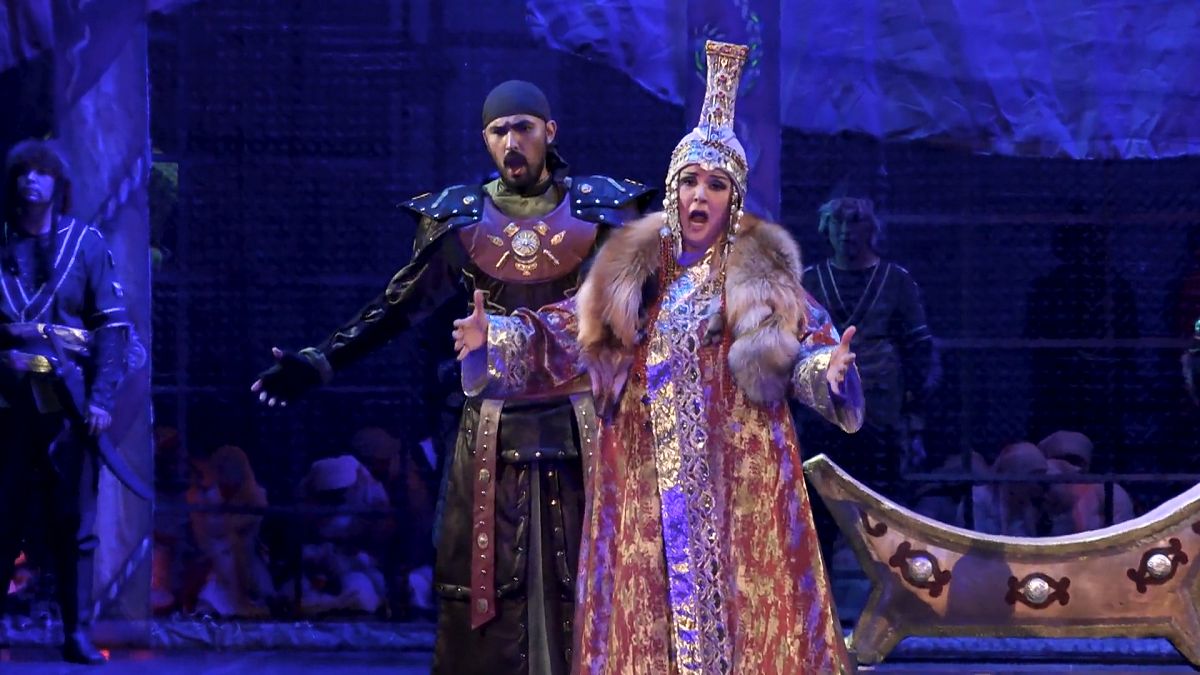Kazakh opera stands as a powerful cultural pillar that blends rich musical heritage, poetic storytelling, and national pride. It reflects the soul of Kazakhstan, combining traditional nomadic elements with European operatic styles. As it continues to evolve, Kazakh opera does more than entertain—it celebrates identity, preserves history, and communicates a unique voice to the world stage.
The Origins: A Fusion of Cultures
Kazakh opera emerged in the early 20th century, during a time of profound cultural transformation. The Kazakh people, with their centuries-old oral traditions, already possessed a strong musical and poetic foundation. The akyndyq tradition—where akyns (improvisational poets) recited epic poems accompanied by the dombra (a traditional two-stringed instrument)—provided the emotional and narrative roots of Kazakh opera.
However, the influence of Russian and European classical music began to shape Kazakh performance arts in the 1920s and 1930s. Composers and artists sought to blend Western operatic structure with native Kazakh themes. As a result, a new genre was born—Kazakh opera—where arias replaced zhyrau chants, and orchestras supported ancient melodies.
Milestone Work: Kyz Zhibek and the Birth of a Tradition
In 1934, Kazakhstan witnessed the premiere of its first national opera, Kyz Zhibek, composed by Yevgeny Brusilovsky and based on the beloved Kazakh epic poem. This opera became a landmark not only for its musical innovation but also for its cultural significance.
Kyz Zhibek told the tragic love story of two young lovers, Tolegen and Zhibek, reflecting universal themes through a Kazakh lens. Audiences connected deeply with its pastoral imagery, melodic richness, and emotional intensity. This production proved that opera could serve as a modern vehicle for ancient stories and traditions.
Following this success, composers like Mukan Tulebayev, Latif Khamidi, and Akhmet Zhubanov contributed to the growing body of Kazakh operatic works. Tulebayev’s Birzhan and Sara became another masterpiece, showcasing the poetic duel between two legendary figures and adding emotional depth to the genre.
Instruments, Language, and Style: A Unique Sonic Landscape
Kazakh opera does not simply copy Western opera. Instead, it introduces a new dimension to the form by incorporating traditional Kazakh instruments like the dombra, kobyz, and sybyzgy. These instruments create a distinctive soundscape, filled with echoing harmonics and earthy tones that resonate with the steppes.
Moreover, Kazakh opera proudly features the Kazakh language. While some performances include Russian or even Italian, most operas use Kazakh as the primary language. This linguistic choice roots the art form deeply in the national psyche and makes each performance a celebration of heritage.
Vocally, Kazakh opera requires singers to blend classical technique with traditional singing styles. Performers must master both bel canto and the powerful, chest-resonant timbre characteristic of Kazakh folk music. This fusion creates emotionally charged performances that captivate audiences.
Staging and Costume: Visual Symbols of Identity
Kazakh opera also pays meticulous attention to visual storytelling. Staging often reflects nomadic life, ancient battles, or natural landscapes. Directors recreate yurts, mountains, and vast steppe scenes to immerse audiences in the national setting.
Costumes, meanwhile, are richly embroidered and historically accurate. Designers use wool, velvet, and silk, adorned with silver ornaments and traditional patterns. Each costume tells its own story, connecting characters to tribal, historical, or mythical contexts.
Institutions and Icons: Nurturing the Tradition
Several institutions play vital roles in preserving and promoting Kazakh opera. The Abay Kazakh State Opera and Ballet Theatre in Almaty, founded in 1934, remains the premier venue for national opera. Named after the great Kazakh poet and philosopher Abay Qunanbayuli, the theatre serves as a beacon for cultural innovation and excellence.
Other key institutions include the Astana Opera House and regional theatres in cities like Shymkent and Karaganda. These venues train new talent, commission new works, and keep classical pieces in active rotation.
Legends such as Kulyash Baiseitova, the first Kazakh opera diva, and Ermek Serkebayev, a celebrated baritone, elevated Kazakh opera to global recognition. Today, artists like Maira Mukhamedkyzy and Medet Chotabayev continue to represent Kazakhstan internationally, bringing national stories to global audiences.
Global Recognition: Taking Kazakh Opera Abroad
Kazakh opera has increasingly found international acclaim. Productions have toured in Europe, Asia, and the Americas. International festivals now feature Kazakh operas, and collaborations with foreign composers and directors grow each year.
These global showcases do more than entertain—they help define Kazakhstan’s cultural identity on the world stage. They show that Kazakh traditions can stand shoulder-to-shoulder with Italian, German, or French operas, offering fresh perspectives and emotional depth.
Kazakhstan’s government and cultural institutions have recognized this potential. They invest in education, sponsor tours, and support young artists through grants and scholarships. Consequently, Kazakh opera has become not only an art form but also a tool of cultural diplomacy.
Modern Innovations: Opera in the Digital Age
Today, Kazakh opera continues to evolve. Directors experiment with multimedia elements, digital projections, and modern choreography. Some productions reinterpret classic operas with futuristic staging or minimalist design. Others embrace crossover genres, blending jazz, electronic music, or even hip-hop with traditional opera.
These innovations attract younger audiences and expand the opera’s relevance in the digital age. Streaming platforms now host performances, enabling global access and growing international fan bases.
Conclusion: A Living, Breathing Cultural Heritage
Kazakh opera represents more than music—it is a living expression of identity, emotion, and history. It honors ancient traditions while embracing modern innovation. It connects the past with the present and unites the local with the global.
As Kazakhstan continues to assert its cultural voice on the world stage, Kazakh opera stands proudly at the forefront. Through music, poetry, and performance, it carries the spirit of a nation across borders and generations.




